Severe turbulence, record rainfall, killer heatwaves and raging wildfires to name but a few: is it just me, or is “Is Earth’s weather getting weirder?” The answer? Yes. Well, sort of.
These weather events have happened in the past, but the problem is nowadays they’re happening more frequently and to a far greater extent.
What’s causing this uptick in “global weirding” and is there anything we can do about it? Space.com spoke with a leading climate scientist Katharine Hayhoe to learn more about this strange surge in weird weather events and what it means for us.
Related: Scientists are mapping Earth’s rivers from space before climate change devastates our planet
It’s no secret that Earth’s climate has changed dramatically over its 4.5 billion-year history. Nature has seen both warmer and colder conditions before. But it is the current rate of change that is putting the living world at risk.
“Each of us, wherever we live, are experiencing the impacts of climate change today,” climate scientist Katharine Hayhoe told Space.com in an interview.
Some of us might not even be aware of the impacts climate change is having on our everyday lives. From how more extreme weather events are causing home insurance rates to rise, or how our food is becoming less nutritious and drinking water more scarce, whether we like it or not, we are all affected by climate change.
One significant direct effect of climate change is the upturn of extreme weather events that put lives at risk and have a huge economic impact. Extreme weather events attributable to climate change cost the world $143 billion USD per year, the majority of which (63%) is due to loss of human lives, according to a research paper published in the Journal Nature in 2023.
But just how is Earth’s weather getting weirder?
Heat waves
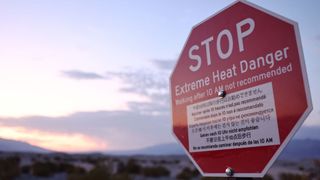
Let’s begin with one of the more obvious effects of climate change: heat waves. As the world gets warmer, heat waves are not only becoming more frequent but also much more intense.
The recent heat wave along the U.S. West Coast saw Las Vegas hit its all-time temperature record of 120 degrees Fahrenheit (49 degrees Celsius). Approximately 36 million people were exposed to an excessive warning during the extreme heatwave with temperatures running as much as 20 degrees above average for this time of year.
Each of us, wherever we live, are experiencing the impacts of climate change today
Katharine Hayhoe, climate scientist
In Saudi Arabia, over 1,300 people died during the annual Hajj pilgrimage that coincided with an exceptional heatwave. Temperatures of 125 degrees Fahrenheit (52 degrees Celsius) were reported at the Grand Mosque in Mecca, according to the BBC. Greece has just experienced the earliest heatwave recorded in the country, and several tourists died, including British TV and radio presenter Michael Mosley. Meanwhile, northern India is reeling from the most severe heat waves it has ever seen with reported temperatures of 120 degrees Fahrenheit (49 degrees Celsius). Summers in India are notoriously hot and humid, but this year’s heat waves have been longer, more intense and far more frequent, according to the BBC.
Heat waves occur when a high-pressure atmospheric system moves in and pushes warm air down toward the ground. The trouble we are currently facing is that the high-pressure systems are being reinforced as the planet warms, catalyzing a vicious cycle.
“The warmer it is, the stronger the high-pressure system, and the stronger the high-pressure system, the warmer it is,” Hayhoe explained.
Heavy rainfall and flash floods
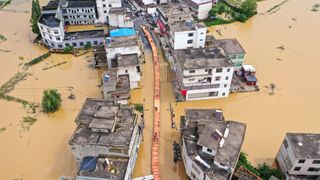
Another by-product of a warmer world is that a warmer atmosphere holds more water vapor. Wherever moisture-laden air passes over land or converges into a storm system, it can produce more severe precipitation, for example, heavier rain and snow storms.
Atmospheric rivers are one of the big players when it comes to heavy precipitation events. An atmospheric river is a river of moisture in the sky. When one of these approaches a mountain, the air is forced to rise. As it does, the air cools and the water condenses and falls out as rain.
“So what’s happening is atmospheric rivers are getting stronger and bigger because they’re picking up a lot more water vapor. After all, the warmer it is, the more water evaporates from the ocean.” Hayhoe continued.
During the 2023/2024 fall and winter seasons, rainfall in the U.K. and Ireland was about 20% heavier due to human-induced climate change, according to the World Weather Attribution.
This year, downpours and floods have already wreaked havoc around the world, and it doesn’t look like stopping anytime soon. In May a catastrophic flood struck Afghanistan, killing over 300 people in the provinces of Baghlan, Takhar and Badakhshan. In June, heavy rain swept across Switzerland, France and Italy causing landslides and torrential floods, at least seven people are reported to have been killed. In India, Nepal and Bangladesh large-scale flooding is not uncommon during the monsoon season but this year’s abnormally early heavy rainfall has killed more than 40 people so far.
Hurricanes, typhoons and cyclones
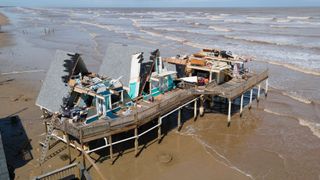
Hurricanes and typhoons are a type of weather phenomenon known as tropical cyclones. Tropical cyclone is an overarching term used to describe a rotating, organized system of clouds and thunderstorms that originates over tropical or subtropical waters and has closed low-level circulation, according to the National Oceanic and Atmospheric Administration (NOAA). Once wind speeds reach 74 miles per hour or higher, a tropical cyclone is classified as a hurricane, typhoon or tropical cyclone depending on where the storm originates. The term hurricane is used in the North Atlantic, central North Pacific, and eastern North Pacific. The term typhoon is used for a disturbance in the Northwest Pacific, while the generic tropical cyclone term is used in the South Pacific and Indian Ocean.
No matter their name, these storms are unique in that they’re powered by warm ocean water.
The planet’s oceans are particularly vulnerable to climate change and our warming world. “90% of the extra heat being trapped inside the climate system is going into the ocean, not the atmosphere,” Hayhoe explained. This means that there is a lot of energy to power stronger storms. As such, a far greater proportion of named storms are further intensifying and developing into hurricanes, typhoons and tropical cyclones.
“The storms are not only there intensifying faster, they’re moving more slowly. So they’re sitting over you for longer and they’re dumping much more rain,” Hayhoe continued.
Hurricane Harvey, which hit the U.S. in 2017, was the first significant hurricane to hit the U.S. where scientists could calculate how much of an effect climate change had on the event. Scientists found that climate change made the rainfall over Houston, Texas, during the hurricane event, three times more likely and 15% more intense.
Wildfires
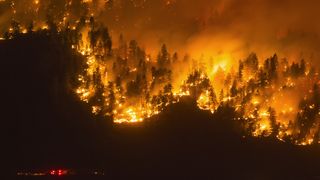
Another significant effect of climate change is a rise in how often severe wildfires occur. Wildfires have destroyed over 1.7 million acres of land during the first three months of 2024 in the U.S. alone, according to the Independent.
Though a majority of wildfires in heavily populated areas like the U.S. are due to accidental human ignition, they are exacerbated by climate change, specifically hotter, drier weather.
“Imagine that you accidentally drop a match into a pile of green wet wood. What happens? Not much, imagine if there’s snow around the wood, nothing happens” Hayhoe explains “Now imagine you drop that match into a pile of bone dry wood that’s been baking in extreme heat for weeks, and even months,” Hayhoe continues.
“That’s why we see that the area burned by wildfires and the number of large wildfires is increasing.”
Wildfire seasons are also coming earlier and lasting longer. For example, this year’s wildfire season in Canada began in February, just like it did last year. In the past, however, it wouldn’t start until March.
Last year (2023), Canada witnessed a fire season like no other, with approximately 45 million acres burned by over 6,500 fires. To put this into perspective, the total area burned in 2023 was eight times higher than the 40-year average, according to a report by the BBC.
Wherever we look around the world, we see that these weather events are getting supersized by climate change, and they’re putting us all at risk
Katharine Hayhoe, climate scientist
Unfortunately, this devastating scenario will become more common due to climate change.
Unlike U.S. wildfires, most of the wildfires in the northern forests, like the ones observed in Canada, are caused by lightning strikes, not humans. Scientists predict an increase in lightning frequency by 11-31% for every degree of global warming, according to the BBC’s report. This is because warmer air can hold more moisture, about 7% more moisture per 1.8 degrees Fahrenheit (1 degree Celsius) of warming. As moisture is a key ingredient in thunderstorm development, the more moisture in the air, the higher the chance of thunderstorms and accompanying lightning strikes.
Air turbulence

In May 2024, a Singapore Airlines flight encountered a severe bout of turbulence which left one person dead from a suspected heart attack and several others badly injured. The same month, a Qatar Airways flight from Doha to Ireland endured strong turbulence over Turkey, leaving 12 people injured. In July 2024, dozens were injured after an Air Europa flight was hit by severe turbulence; the flight from Spain to Uruguay had to make an emerging landing in Brazil.
A bit of turbulence is par for the course for air travelers. But a recent uptick in severe incidents has left people wondering whether climate change is to blame.
It’s a difficult one to pin directly onto climate change but there is evidence to support that it could be increasing the risk of turbulence, according to the BBC.
Two main types of air turbulence affect air travel, one is from thunderstorms and the other is called “clean air” turbulence.
Turbulence caused by thunderstorms is likely to increase because the frequency of thunderstorms is increasing due to climate change, as previously discussed. But this type of turbulence is less problematic for pilots, as it is linked to storms and therefore easier to predict.
The other type, “clean air” turbulence, also called “invisible turbulence” is highly unpredictable and is one of the largest causes of weather-related aviation incidents. It is expected to worsen with climate change, and under specific climate change scenarios, it could become four times
more frequent by 2050 compared to historical levels.
All hope is not lost

“Wherever we look around the world, we see that these weather events are getting supersized by climate change, and they’re putting us all at risk,” Hayhoe explains.
Though it may be hard to find any positives in a sea of negative climate change news, rest assured that the tides are changing. People are increasingly recognizing the impacts and severity of climate change. However, it remains uncertain if this awareness is spreading quickly enough. What is clear is that we all share responsibility for climate change and can take steps to mitigate it.
Without action, there is no hope.
What you can do to help
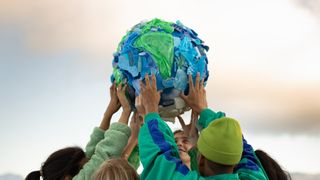
If you’re like me and often feel overwhelmed by the negative effects of climate change while also thinking “How can I help, I’m just one person?” Hayhoe has laid out a great list of how individuals can help catalyze change for the better and feel like they are making a difference.
- Start a conversation about why it matters, and what people can do. “That’s why I do my newsletter every week,” Hayhoe explains. Every week Hayhoe provides a clear-eyed and hopeful look at climate science and solutions.
- Join a climate action group. Don’t be alone, join one in your town, in your city, at your school, at your church, wherever it is. And if you don’t have one, think about setting one up, Friends of the Earth have some useful tips on how to start.
- Consider where you keep your money. “Where we bank, the credit card we use, where we have our pension or retirement, if it’s invested in fossil fuels, it’s perpetuating the system,” Hayhoe explains. We should be looking at banks that invest in clean energy and environmentally friendly enterprises like clean energy, that way we are actively contributing towards a better world with our own money.
- Spark ideas for change wherever you work or wherever you go to school. “That’s using your voice specifically, saying why don’t we do this together as a business or an organization?” Hayhoe says.
- Hold politicians accountable. Hayhoe explains that this doesn’t only mean voting but also using your voice to tell them why it matters. “Studies have shown that politicians consistently underestimate how concerned their constituents are because they don’t hear from them enough,” says Hayhoe.
- Reduce your personal footprint. The environmental charity World Wildlife Fund has some useful resources on how you can reduce your carbon footprint, from changing the way you travel to what you eat.



